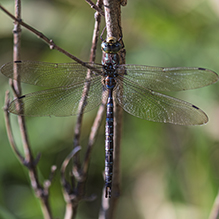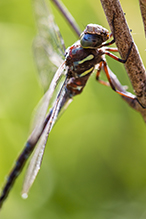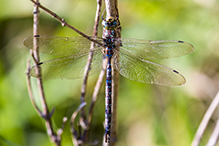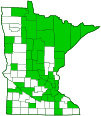shadow darner
(Aeshna umbrosa)
Conservation • Description • Habitat • Ecology • Distribution • Taxonomy
|
|
|||||||||||||
Description |
Shadow darner is a common and widespread, 2¾″ to 3″ long, mosaic darner (genus Aeshna). It is found throughout North America except in the arid southwest and, for some reason, Newfoundland. It is a late-season dragonfly. Only the autumn meadowhawk (Sympetrum vicinum) flies later in the year. The face is pale grayish-green and lacks the black horizontal stripe found on many other species of dragonflies. There is a black T-shaped spot on the upper part of the face (frons) below where the eyes meet. The lower leg of the T spot is slightly constricted in the middle. The compound eyes meet along a long margin at the top of the head. The lower back of the head is brown. The thorax is brown with two shoulder (dorsal) stripes and a pair of side stripes on each side. The shoulder stripes are blue. The side stripes are parallel and greenish-yellow for most of their length, fading to bluish-green at the top. The front (anterior) stripe is straight and complete, not bent, notched, or interrupted. The bottom widens slightly and there is a small rearward extension at the top. The abdomen is brownish-black and slender. Abdominal segment 3 is elongated and noticeably constricted when viewed from above. Abdominal segments 1 through 9 have a pair of pale blue spots on the upper (dorsal) surface that get darker in cool weather. Abdominal segment 10 on the male is unmarked. These spots are narrower than those on other blue darners. The pale areas on the underside on the abdomen are large, bright, and green on the eastern subspecies, blue on the western subspecies. Females are usually colored similar to males but there is a rare green form female with green dorsal spots on the abdomen. On the male the pair of appendages at the end of the abdomen (cerci) are expanded at the tip and twisted downward. They appear wedge-shaped when viewed from the side. The wingspan is about 3⅜″ to 4″. The wings are clear. The forewings are slightly narrower than the hindwings. |
Size |
2¾″ to 3″ |
Similar Species |
Lance-tipped darner (Aeshna constricta) front thoracic stripe is slightly notched in the middle. The abdomen has larger blue dorsal spots, normal for darners. The cerci are darker. It flies in open sunlight. |
Habitat |
Shaded areas alongside slow streams, ponds, and swamps; ditches. |
Ecology |
Season |
Late June to late October |
Behavior |
Adults hunt mostly in the shade and mostly at dusk. |
Life Cycle |
The female deposits eggs either in wet rotting wood of a floating or submerged log or inside the stem of emergent vegetation. The eggs hatch about a week later or, in harsher climates, enter a period of decreased metabolic activity (diapause) that lasts up to 7 months. The hatched larva (naiad) grows to be 1½″ to 1¾″ long. In Minnesota it usually takes a year for a naiad to mature and emerge as an adult. In warmer climates the naiad matures in about 2 months. In colder climates it may take several years. Most adults live for about 2 weeks, though those who endure a harsh winter as a naiad may live 2 months or more. |
Naiad Food |
Mostly aquatic insect larvae, but also freshwater shrimp, tadpoles and small fish. |
Adult Food |
Mosquitoes, midges, other dragonflies, moths, grasshoppers, beetles, and any other insects smaller than themselves. |
Distribution |
||
|
Sources Biodiversity occurrence data published by: Minnesota Biodiversity Atlas (accessed through the Minnesota Biodiversity Atlas Portal, bellatlas.umn.edu, 8/6/2025). Haarstad, J. 1997. The dragonflies of selected eastern Minnesota rivers. Report submitted to the Minnesota Department of Natural Resources. Unpaged. Steffens, W. P., and W. A. Smith. 1999. Status survey for special concern and endangered dragonflies of Minnesota: population status, inventory and monitoring recommendations. Final report submitted to the Natural Heritage and Nongame Research Program, Minnesota Department of Natural Resources. 54 pp. |
|
| 8/6/2025 | ||
Occurrence |
||
Common and widespread in Minnesota |
||
Taxonomy |
|
Order |
Odonata (dragonflies and damselflies) |
Suborder |
|
Superfamily |
Aeshnoidea |
Family |
Aeshnidae (darners) |
Genus |
Aeshna (mosaic darners) |
Subordinate Taxa |
|
eastern shadow darner (Aeshna umbrosa umbrosa) western shadow darner (Aeshna umbrosa occidentalis) |
|
Synonyms |
|
Aeschna occidentalis Aeschna umbrosa |
|
Common Names |
|
shadow darner |
|
Glossary
Cercus
One of a pair of small sensory appendages at the end of the abdomen of many insects and other arthropods. In Odonata, one of the upper claspers. Plural: cerci.
Diapause
A period of decreased metabolic activity and suspended development.
Frons
The upper front part of an insect’s face, roughly corresponding to the forehead.
Naiad
The aquatic larval form (nymph) of a dragonfly, mayfly, or stonefly.
Visitor Photos |
||
Share your photo of this insect. |
||
This button not working for you? |
||
|
||
|
||
MinnesotaSeasons.com Photos |
||
 |
 |
|
 |

Slideshows |
Shadow Darner |

|
About
Copyright DianesDigitals |
Aeshna umbrosa (Shadow Darner) |

|

Visitor Videos |
||
Share your video of this insect. |
||
This button not working for you? |
||
|
Other Videos |
||
Shadow Darner - September 14, 2014 |
About
Published on Sep 15, 2014 Shadow Darner (Aeshna umbrosa), Perched on Colorado Blue Spruce (Picea pungens) branch, Gagnon Wildlife Habitat, Somerset, Massachusetts, Sunday morning, September 14, 2014, 9:28 AM - Panasonic Lumix DMC-FZ70 00710; 40 sec. |
042 |
About
Published on Jan 11, 2013 Dec. 5, 2012, Temps low 50's down to 47, raining, Lake Placid, NY Found this aesha, (darner) species of dragonfly swimming around in 1" of water over the ice. Believe it is Aeshna umbrosa, (Shadow Darner), as that is the only aeshna species to have emerged from my female-made vernal pond. We figure is does this due to lack of oxygen in the pond at this time of year. I've seen this happen before this year, but only took photos. |
Shadow Darner Hovers |
About
Uploaded on Mar 27, 2011 September 28, 2010 A Shadow Darner hovers near me -- in the shadows. |
Shadow Darner Dragonfly |
About
Published on Nov 19, 2014 A shadow darner dragonfly flies over our pond in search of insects |
MVI 080511 shadow darner |
About
Uploaded on Aug 8, 2011 hadow Darner ovipositing on the evening of August 5, 2011 |

Visitor Sightings |
||
Report a sighting of this insect. |
||
This button not working for you? |
||
|
|
MinnesotaSeasons.com Sightings |
||

Created: 10/4/2015 Last Updated: © MinnesotaSeasons.com. All rights reserved. |
